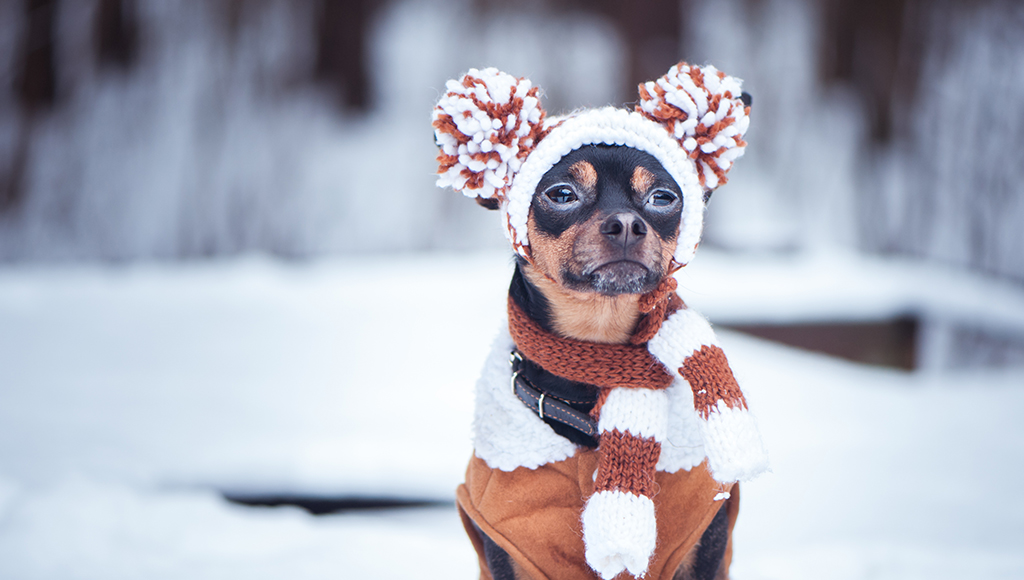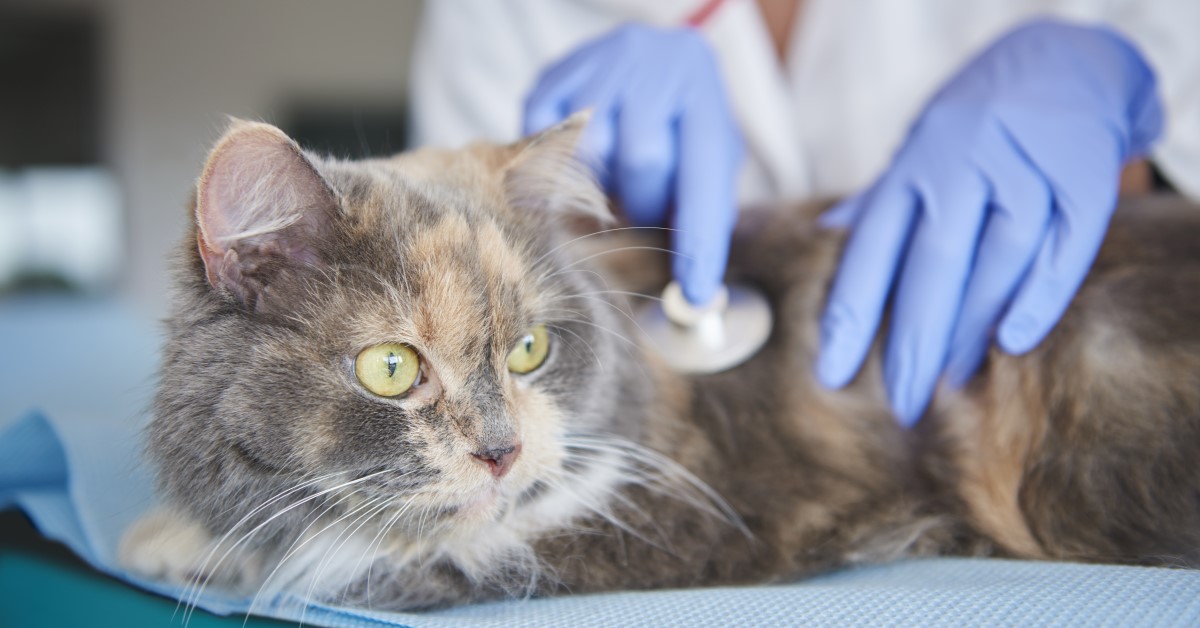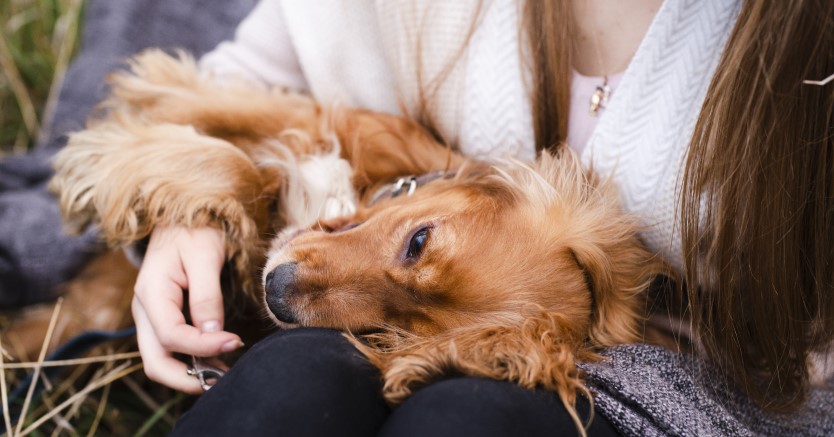Changing Seasons and Your Pets
Here are some tips to remember to help your pets adjust to the changing temperatures.

As the summer comes to an end and fall temperatures start to
filter in slowly, remember your pets and the adjustments they
will have to make with the cooler weather. Below are some tips to
help you and your pet enjoy a safe, healthy, comfortable
winter:
Before, during and after walks and outdoor
exercise:
* In the colder climates and chillier temperatures, coats and
booties can help your dog stay warm. In particular, shorthaired
or elderly dogs benefit from wearing a coat or sweater. Look for
coats or sweaters with high collars or a turtleneck that covers
the dog from the base of the tail on top to the belly
underneath.
* Remember to be very careful with sick or older dogs, since they
are more sensitive to cold weather. For any dog sensitive to the
cold due to age, illness or breed, take him outdoors only to
relieve himself.
* Puppies do not tolerate the cold as well as adult dogs and may
be difficult to housebreak during the winter. If necessary,
paper-train your puppy inside if he appears to be sensitive to
the weather.
* If you live in an area that sees a considerable amount of snow,
clip the fur between your dog’s toe pads to reduce the amount of
snow that collects between toes.
* To help protect dry, sensitive paws, try coating them with a
bit of cooking spray before walks in very cold weather.
* If your area endures deep snows, help your dog by shoveling out
a potty spot for him. It may seem like a bit of extra work or
even silly, but without an easy place to relieve himself, your
dog just may refuse to go outdoors and leave you with a mess to
clean up.
* Upon returning home, immediately wipe any snow and ice off your
dog's feet, legs and belly. Little ice cubes can form in the
sensitive spaces between the toes and toe-pads. Remove the ice
carefully with your fingers since it may cling to the hairs
between the paws. Wiping off your dog will remove any salt,
antifreeze or other harmful chemicals that he could ingest when
licking his paws.
* Consider keeping a container of warm water and cloths by the
door for use after walks. It is good to rinse the paws before you
wipe them dry, because lime rock salt and calcium chloride salt
can irritate the footpads and cause vomiting and diarrhea when
licked. Dunking in the water will also dissolve any ice and
remove mud.
* Many de-icing and ice-melting products are toxic. Read the
labels of any projects you use, and store these products in tight
containers.
* Even brief exposure to sub-zero temperatures can lead to
frostbite of the feet, nose or ears. Frostbitten skin appears
red, gray or whitish and may peel off. Prevent frostbite by
removing ice and snow from paws and fur right away. If you
suspect frostbite, take your pet to a warm place and thaw out
frostbitten areas slowly by applying warm, moist towels. Change
them frequently. Continue until the affected areas become
flushed. Then contact a veterinarian for further care.
* Do not be tempted to let dogs off their leash in snow or ice.
Canines often lose their scent in cold weather and can easily
become lost. Dogs can also panic in snowstorms and run away. The
decreased daylight does not help either. More dogs are reported
lost during the winter than any other season, so always keep dogs
on a leash when outside a fully fenced yard and make sure your
dog always wears proper identification.
Winter pet care:
* Brush your dog vigorously and regularly. The air in most houses
becomes dry during the colder months, which depletes moisture
from dog skin and fur. Brushing improves skin, coat and
circulation.
* A thick-coated dog typically needs grooming in cold weather.
The fur can get wet and matted, making it an irritant. Clean fur
lofts and holds air in a manner similar to layering clothes, thus
helping the animal stay warm.
* Never shave your dog down to the skin in winter. Leave the coat
longer for more warmth. When you bathe your dog, completely dry
him before taking him out for a walk.
Safety measures:
* Do not leave antifreeze, coolant or windshield wiper fluid
within reach. And do not let pets drink from puddles. These
products taste appealing to pets but most are lethal to animals
when ingested. Thoroughly clean up any spills from your vehicles.
Also, keep your pets on leash outdoors and steer them far away
from any suspect puddles.
Consider using products that contain propylene glycol rather than
ethylene glycol. Some companies offer non-toxic antifreeze
products, such as Sierra. Be sure to have your radiator flushed
before you fill it with Sierra and do not mix Sierra with
traditional antifreeze.
* Keep a winter survival kit in your car. Include blankets,
towels, water, bowl, first aid kit, and a sign that dog is in the
car.
* Never leave your dog or cat alone in a car during cold weather.
A car can act as a refrigerator in the winter, holding in the
cold. The animal can freeze to death.
* Cats left outdoors and wild animals sometimes climb onto car
engines or beneath cars to seek warmth. Please bang on the hood
of your care honk the horn or tap the tires before starting the
engine to warn cats away.
In-home health and safety:
* Provide your pet with a warm place to sleep, away from drafts
and off cold, hard floors. Dog and cat beds with a warm blanket
or cover are especially cozy.
* If you know people who keep dogs in basements or tiled rooms,
remind them that tile and uncarpeted areas can get very cold.
* The dryness in our homes can make animals more susceptible to problems such as dry noses, upper respiratory infections, dandruff, itchy skin, hair texture changes, dry throats and more.
1. Use a humidifier. Consider a model that humidifies and purifies the air.
2. Add skin conditioners to the diet. Your veterinarian can recommend the best products for your pet.
3. Groom your pet regularly to prevent matting. A well-groomed fur coat will lie down smoothly and act as a thermal layering much like a coat would for us. A matted coat will not warm the animal.
* Portable heaters and fireplaces can be deadly hazards for
animals and children. Screen fireplaces and put portable heaters
out of your pet’s reach no matter what size or breed. Do not run
portable heaters in a room where your pet is unless there is
someone there to monitor them. When you leave the room, always
turn the portable heater off.
Emergencies:
* To avoid injuries, hypothermia and drowning, don't let dogs or
kids venture onto frozen ponds.
* If your dog falls through ice into water, heed this guidance
about drowning from Dr. Stefanie Schwartz, author of First Aid
for Dogs:
1. If the dog is limp, unconscious or unresponsive, wrap him in a
towel. Keep the neck and back immobilized to avoid aggravation of
possible spinal injury. Place the dog on a flat board for
transporting.
2. If the dog is not breathing, lay him flat on his right side.
Make several quick compressions to his chest to expel water, and
then feel for a heartbeat just behind the left elbow. If there's
a heartbeat, but the dog is still not breathing, check the back
of his throat for obstructions.
3. If you feel no obstruction, close the dog's muzzle by firmly
encircling it with your hand. Put the dog's tongue in his mouth
first so he doesn't bite it. Then, blow into his nose. Adjust the
force of your breath to the size of dog. Watch for rise of his
chest, and keep checking for a heartbeat.
4. If you can't feel a heartbeat, make one or two quick firm
compressions on the chest wall with both of your palms flat on
top of each other, and begin artificial respiration. Blow about
15 breaths followed by chest compression. Continue until the dog
regains consciousness, respiration and heartbeat return, or until
emergency assistance takes over.
* Keep Rescue Remedy on hand. It's a Bach flower essence
available in most health food stores. This gentle, natural stress
reducing liquid can help people and animals recover from injury,
fright, illness, travel fatigue and irritation. Put a drop
drinking water. To help prevent travel sickness, a common dosage
is four drops in the mouth about ten hours before the trip,
repeating every four hours as needed. For stressed or injured
animals, rub a drop on their ear or put a drop on the towel in
their crate or carrier.
* If you see an animal in distress, please call your local humane
society right away. It doesn't take long for companion animals to
suffer and fall victim to severe winter weather. Frostbite occurs
when the fluids in tissues freeze, frequently on the tips of the
ears, paws or pads, flanks and belly. Hypothermia, which can lead
to death, occurs when the animal's body temperature drops
significantly below normal, causing the bodily systems to shut
down. Furthermore, pets left outside are deprived of water, since
water freezes at 32 degrees.
Leaving pets outdoors:
* If you know anyone who keeps pets outdoors, persuade them to
bring them inside, especially overnight when the temperatures
drop their lowest. Low temperatures, winds and precipitation can
lead to illness and death. In addition, water bowls freeze in
cold weather.
* Remember, dogs are domesticated animals that should live
indoors with their human companions. Living outside in a doghouse
is not the best for your pet, especially in cold, hot and wet
weather.
* Please keep cats inside. Felines who spend time outside can
freeze, or get lost or injured.
* Dog houses and the law: Local laws typically require that if
dogs are kept outdoors, the owner must supply the dog with
"proper" shelter from the weather, which includes a dog house big
enough to stand up in and to permit posture positions that allow
the dog to stretch out and stand up, but must not be oversized,
since the dog needs to retain body heat; a wind flap on the dog
house door; nonporous bedding such as straw; and, access to
fresh, unfrozen water.
* If you see a dog in need of a caring friend, become that dog's advocate. Speak with the owner, and if that fails to improve the situation, contact your local SPCA, humane society of animal control office.
Ready to start saving money on pet wellness care?
Then take a look at Mint Wellness, the pet wellness plan that provides fast reimbursement on routine pet care. Save on vaccinations, wellness exams, preventatives, dental, and more!
Learn More


